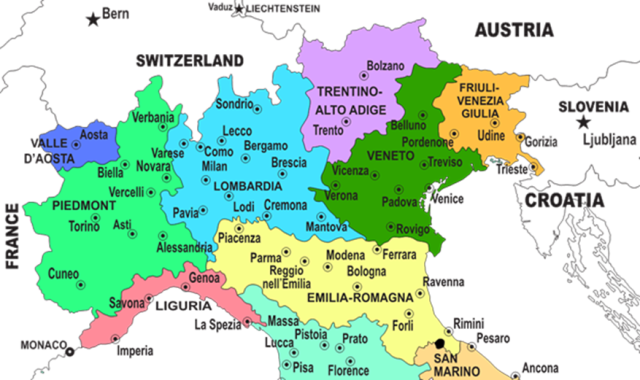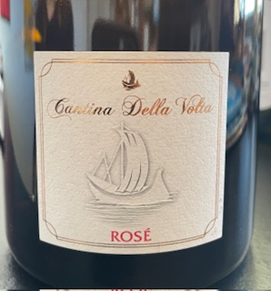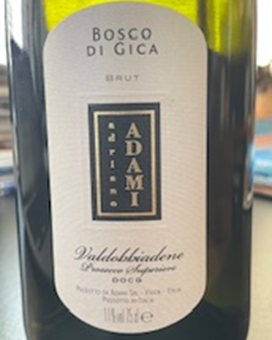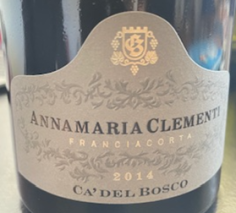
Tasting No 261 Jan 30, 2024 Northern Italian Sparkling Wines
2024 Wine Tasting Calendar < click here to the newest version of the calendar.
1. Tasting Overview
The main objective of this tasting is to explore different types and offerings of Northern Italian Sparkling Wines. The first tasting of the year will be of the best Italian Sparkling Wines and allow us to sample top sparkling wines in a variety of grapes, production methods, terroirs and acidity/sugar content. This should bring cheers with the bubbles and the new year.
Type of tasting: Open
Presenter: Laura Bocalandro
Participants:
S. Ardila; M. Averbug; L. Bocalandro; J. Brakarz; J. Entwistle; C. Estrada; M. Fryer; J. García; N. Marzella; J.&L. Redwood; R. Santiago; J. Sanchez; E. Silva; P. Turina; L. Uechi; R. Zavaleta.
Wines:
- Cantina della Volta, Lambrusco di Sorbara, Rosé Brut Spumante, DOC, 2017
- Ferrari, Sparkling Wine Brut, Trento DOC, NV
- Adriano Adami, Bosco di Gica, Prosecco Superiore, Valdobbiadene, DOCG, NV
- Cá del Bosco, Anna Maria Clementi, Franciacorta Riserva, DOCG, 2014
-
Menu (the wines will be served all at once)
- Seafood Salad
- Fettuccine with Aurora Sauce
- Salmon Grille with broccoli and green beans
- Dessert
-
The Sparkling Wines of Northern Italy
The sparkling wines of northern Italy have a long tradition of producers, production methods and more recently quality controls and certifications.
Sparkling wines benefit from a series of institutions that safeguard the production, designation and quality, as well as promote the different Italian sparkling wines. The Consorzio per la Tutela del Franciacorta was created in 1990 and the Consorzio per la Tutela del Prosecco was established in 2009, shortly after the date on which Prosecco was recognized as a wine with a Controlled Designation of Origin. These Consortia aim to voluntarily associate winemakers, winemakers and sparkling wine producers to guarantee the development of the Denomination and compliance with the rules set out in the Production Regulations.
In addition, the concern for the certification of origin and quality control led to the creation in 1979 of the Federdoc, the National Confederation of Voluntary Consortia for the Protection of the Designations of the Italian Wines. This organization represents almost all the universe of the Italian Designations and their Consortia, and it supports them on an institutional, legal and legislative level. Federdoc: “the designation of origin” of Italian consortia.
Production methods:
There are two production methods for sparkling Italian wines: the Charmat/Martinotti method and the traditional method or metodo classico.
- Metodo Charmat: Primary and secondary fermentation in stainless steel, filtered into a tank and bottled. Also known as: Tank method, metodo Italiano, Martinotti method or autoclaves. Examples could be a Prosecco or a Lambrusco di Surbara.
It is used to produce spumante and frizzante sparkling wines with distinctive floral and fruity notes, through a natural second fermentation process in large, sealed tanks (autoclaves). Dr. Antonio Carpenè, one of the founding members of the Conegliano School of Winemaking, was the first person to use this method to produce sparkling Prosecco wine with the characteristics that are so well known today. Prior to this, the wines were produced using second fermentation in the bottle.The autoclave, or closed tank fermentation, was first invented by the French chemist Edme-Jules Maumené in 1852, adapted for commercial use by the Italian Federico Martinotti, and perfected for use with stainless steel by another Frenchman, Eugene Charmat, in 1907. The process of using a large tank for secondary fermentation is referred to as the Martinotti process in Italy and the Charmat process elsewhere.
2. Metodo classico: The second fermentation takes place in the bottle, with the wine resting on its yeast lees. Also known as: Traditional method, Méthode Champenoise, Méthode Traditionnelle. The main example in Italy is Franciacorta.
Under the metodo classico, the yeast that is in contact with the wine in the bottle during the second fermentation adds a wonderful flavor. This is called “autolysis” and the longer you leave the wine in contact with the yeast lees, the better, up to a point. Also, the bubbles, or perlage, in this fermentation process are finer and last longer in the glass.
The Prosecco: its origins date back at least 2000 years. It was known in Roman times as Pucino (1st century AD – Pliny the Elder). It originated as a still, dry wine produced near Trieste, taking its name from the village of Prosecco. The bubbles first appeared with second fermentation in bottles at the end of the 19th century and then in autoclaves (tanks) in the early 1900s. Today it is made in a very large area covering the Veneto and Friuli Venezia Giulia regions. Sparkling Prosecco was introduced to the US by Mionetto in 2000, and sales have since exploded.
Prosecco can be either still or sparkling. It can be made either using the Charmat/Martinotti process or the methode traditionelle (methode champenoise). The wines range in sweetness from Zero Dosage to Brut (0-12 g/L RS), Extra Dry (12-17 g/L RS), and Dry (17-32 g/L RS). Prosecco wines have become less sweet over time, and Brut (our wine) is about 40 percent of production. Prosecco is lightly effervescent with about 4 atmospheres of pressure, similar to French Cremant, compared to 6-7 for Champagne.
There are five quality levels of Prosecco. Major changes in the categories were introduced in 2009 with the creation of three DOCGs and the designation of Prosecco as a growing region rather than the name of the grape, which is now only referred to as the Glera grape.
The Glera grape is native to Northeastern Italy, and it is the traditional grape variety used for Prosecco. The native Glera grape must represent a minimum of 85% of all grapes used, and the Verdiso, Bianchetta Trevigiana, Perera, Glera Lunga, Chardonnay, Pinot Bianco, Pinot Grigio and Pinot Nero grapes, vinified off the skins, may also be used up to 15% overall.
The Franciacorta: The sparkling wines of Franciacorta are frequently compared to premium cuvée of Champagne in terms of quality. They are made the same way (méthode champenoise), use the same grape varieties, employ reserve wines to blend across vintages, and do small scale fermentation of different vineyard plots that are later blended into the final cuvée. Unlike Champagne, most Franciacorta producers are also growers. An important part of the Franciacorta ethos is their respect for the environment while championing sustainability and high quality production. The wines are “spectacularly good” and an alternative to other premium sparklers for holiday toasts.
The name Franciacorta most probably comes from the 1100s when the land was known as Francae Curtes, or land free of taxes where the first vines were cultivated. The Franciacorta is a young sparkling wine and it is relatively small with just 106 producers. Its international visibility is limited by the wine’s popularity in Italy, leaving little for the rest of the world. However, some 20 producers now export Franciacorta, giving those living outside Italy the opportunity to experience this delicious sparkling wine. Franciacorta sparkling wines are made from grapes cultivated in 19 communes located in the Province of Brescia, Lombardy. These are grown on hillsides located south of Lake Iseo, which was created by Europe’s last ice age. The glaciers that created the valley ending at Lake Iseo left moraines south of the lake and gave the vineyards of Franciacorta their glacial alluvial soils.
Since the first bottling in 1961, the quality of Franciacorta sparkling wines has impressively improved, in good part due to the creation of the Consorzio per la Tutela del Franciacorta in 1990. The Consorzio has implemented rules delimiting the varieties grown (predominantly Chardonnay and Pinot Noir), production methods (hand harvesting, bottle aging requirements), and yields (60 hectoliters/hectare), some of the lowest in the world. In addition, growers changed their trellising from the traditional pergola to Guyot and spurred cordon, reduced yields with low vigor rootstocks, and planted at higher densities (4-5 thousand vines/ha). These measures significantly improved the quality and reputation of the wines and, also, resulted in Franciacorta being given DOCG status in 1995. Currently, Franciacorta produces about 10 million bottles annually.
There principal producers of Franciacorta are: Bellavista, Ca’ del Bosco, Enrico Gatti, Ferghettina, and Montenisa. And there are five types of sparkling Franciacorta:
- Non-Vintage: Must be aged on the lees at least 18 months. (This is a higher threshold than Champagnes which require only a 12 month minimum).
- Satèn: Non-vintage must be aged at least 24 months; usually 100% Chardonnay. The bottle pressure must be less than 5 atm.
- Rosé: A minimum 35% Pinot Nero is required; the non-vintage rosé must be aged on the lees at least 24 months.
- Millesimato: A vintage wine with at least 85% of the wine coming from the stated vintage; up to 15% can come from reserve wines. Must be aged at least 30 months.
- Riserva: A Millesimato, Satèn or Rosé that spends at least 60 months on the lees in bottle.
-
Information on the Wines
Wine #1: Cantina della Volta, Lambrusco di Sorbara, Rosé Brut Spumante, DOC, 2017
 100% Lambrusco di Sorbara grapes, cultivated on alluvial soil of the Secchia river in the heart of the Emilia Romagna region.
100% Lambrusco di Sorbara grapes, cultivated on alluvial soil of the Secchia river in the heart of the Emilia Romagna region.
Selection of the best Sorbara grapes entirely gathered in small cases (15kg. max); manual harvesting in order to ensure that each grape remains whole, then softly pressed.
After remaining at least six months inside the tanks for maturation process, the wine receives selected yeasts, prior to being bottled. The bottles are then stored horizontally for the long re-fermentation process and maturation, at temperature constantly kept at 12°C.
The following steps are remuage, disgorgement and liqueur d’expédition addition.
Dosage 5.5 g/L. ; Alcohol content is 12.5% by vol.
Producer notes: “Beautiful pale pink dress” covered by gentle, soft foam with fine, tiny and persistent perlage. At the nose, a magic sensation of full aromatic perfumes of raspberry and wild berry well combined with ancient rose and pomegranate tones, grapefruit, face powder. Perceivable acidity, balanced with good salty texture. Structured body, brightened by its unique “acid-savory” synergy, which enhances its floral scent. Elegant and persistent.”
“Red berry, violet and a whiff of brioche form the enticing nose on this lovely sparkler. Dry and savory, the elegant palate features pomegranate, orange zest and bread crust alongside fresh acidity and an extremely refined perlage.” (Wine Enthusiast– 92 pts.).
Wine #2: Ferrari, Sparkling Wine Brut, Trento DOC, NV (Italy Modern)
The Producer: Italy’s celebrated Ferrari winery located just outside the city of  Trento has been producing this NV TrentoDoc Brut sparkling wine since 1902. All of their wines are TrentDoc produced exclusively from grapes grown in Trentino at high altitudes using sustainable farming methods.
Trento has been producing this NV TrentoDoc Brut sparkling wine since 1902. All of their wines are TrentDoc produced exclusively from grapes grown in Trentino at high altitudes using sustainable farming methods.
Ferrari Trento is managed by the grandchildren of Bruno Lunelli who bought the estate in 1952 from Giulio Ferrari. Since 2021 the house of Ferrari Trento are the podium sponsors of the F1.
The vineyards include communes in the Val d’Adige, Val di Cembra and Valle dei Laghi, with S.E. and S.W. exposure the slopes of the mountains of Trentino at an altitude between 200 and 900m over sea level. The climatic variation helps this wine with the cold streams from the Dolomites and the mild temperatures of Lake Garda, thus the grapes develop a higher acidity and aromatic complexity.
The wine: This Ferrari Trento DOC is produced by the metodo classico with more than a hundred years of history. It is produced from 100% Chardonnay grapes with a minimum stay on lees for at least 15 months, which extends to 24 for the Millesimato, and 36 for the Riserva. Our wine has 12.5% alcohol/volume and between 6-12 RS/L sugar residue.
Tasting notes: This wine is a luminous sparkler of pronounced finesse, made with 100% Chardonnay grapes. It is straw yellow with slight green reflections in color. Clean and balanced in taste, with a slight and pleasant finish of ripe fruit and a hint of bread-crust. Aromas of white spring flowers, white orchard fruit and a whiff of brioche lead the way. On the crisp palate, an elegant perlage (bubbles) accompanies creamy yellow apple, pear and lemon drop.
Its straightforward and confident bouquet delivers a clear and precise message of good cheer and easy-drinking appeal. This is the quintessential Italian aperitivo wine. Perfectly served as an aperitif or with lighter dishes, especially seafood.
Wine #3: Adriano Adami, Bosco di Gica, Prosecco Superiore, Valdobbiadene, DOCG, NV
The Producer: Adriano Adami, the producer of our Prosecco Superiore, has  been making Prosecco since 1933. The Bosco di Gica denomination comes from the old name of the area where the family had its first vineyards. For over 90 years Adami has produced only Prosecco Valdobbiadene DOCG and Prosecco DOC Treviso in its various types and expressions, both traditional and more modern, linked to the diversity of each single hill. They are Prosecchi specialists whose first single vineyard selection in 1933 is still the benchmark for the Prosecco today. Adami now produces 750,000 bottles with grapes from 50 hectares of vineyards.
been making Prosecco since 1933. The Bosco di Gica denomination comes from the old name of the area where the family had its first vineyards. For over 90 years Adami has produced only Prosecco Valdobbiadene DOCG and Prosecco DOC Treviso in its various types and expressions, both traditional and more modern, linked to the diversity of each single hill. They are Prosecchi specialists whose first single vineyard selection in 1933 is still the benchmark for the Prosecco today. Adami now produces 750,000 bottles with grapes from 50 hectares of vineyards.
Milan Fashion Week has adopted this Prosecco as its official sparkling wine.
The Wine: This sparkling wine comes from the appellation known as the Cornegiano Valdobbiadene region, which includes the provinces of Treviso, Venice, Vicenza, Padua, Belluno, Gorizia, Pordenone, Trieste and Udine. The land is alluvial in origin and has mainly clay-loam soil, rich in minerals and micronutrients, with a southern exposure and an altitude of 180-300 m above the sea level.
Our wine is made by the Martinotti/Charmat method discussed above. It contains 7-10 RS/L and 11% alcohol by volume. The bottle label includes the Conegliano Valdobbiadene seal with an identification of origin and quality guarantee (DOCG). This label guarantees total compliance with the official product specification, with quality also certified through application of the Government Identification mark (band).
Wine #4: Cá del Bosco, Anna Maria Clementi, Franciacorta Riserva, DOCG, 2014
The Producer: The tiny appellation of Franciacorta was originally created in  1968, Ca’ del Bosco’s first vintage. Ca’ del Bosco is in the top tier of Franciacorta and Maurizio Zanella (owner family) is a perfectionist where nothing is left to chance; its wines are a masterpiece of precision.
1968, Ca’ del Bosco’s first vintage. Ca’ del Bosco is in the top tier of Franciacorta and Maurizio Zanella (owner family) is a perfectionist where nothing is left to chance; its wines are a masterpiece of precision.
In 1988 this Franciacorta took the name of the founder’s mother, Anna Maria Clementi, and became a Zero Dosage sparkling wine to exalt the wine’s purity and integrity.
The Wine: This Franciacorta is produced following the metodo classico.
A blend of 76% Chardonnay, 15% Pinot Nero and 9% Pinot Bianco, it was fermented in small oak casks for six months and matured on the lees for eight long years. This 2014 vintage wine was disgorged in the winter 2021-2022.
12.8% per volume alcohol; zero dosage with a minimum amount of sugar residue (0-3g/L SR).
The bouquet is immediately beautiful with baked apple, brioche, pastry cream and something a little spicy, like a pinch of saffron, that gives extra pop. It shows a mid-weight mouthfeel with a whole other set of almond and bitter lemon flavors. This elegant Franciacorta manages a careful dance between nose and palate.” (95 pts. Wine Advocate)
Sparkling Wines of Northern Italy
Comparing Tasted Wines

-
-
CV Members Rating:
-
The tasting took place before revealing their prices. 14 participants rated them from Acceptable to Exceptional.
The combined results established the preference order during the tasting.
Cá del Bosco, Anna Maria Clementi, Franciacorta Riserva, DOCG, 2014 was rated the Best
Wine . Adriano Adami, Bosco di Gica, Prosecco Supperiore, Valdobbiadene, DOCG, NV the Best Buy.
The following Table presents the details of individual ratings and combined results.

Sources/References: These notes draw heavily from some of the following sources.
Franciacorta/ Italy’s Luxury Sparkling Wines Review – International Wine Review.
International Wine Review. Report #14 The World of Sparkling Wines and Champagne.
10 of the best Italian sparkling wines, and best prosecco brands (italybest.com)
The Sparkling Wines of Italy | Sparkling Winos
A guide to Italy’s sparkling wines | The Wine Society
https://winefolly.com/deep-dive/sparkling-italian-wine/
Home – Prosecco.it — Conegliano Valdobbiadene DOCG
Consorzio Tutela Prosecco DOC | Il segreto sta nell’essere geniali
Consorzio tutela del Franciacorta, Strada del Franciacorta
.o0o.
Italiano Vero
Con la chitarra in mano
Lasciatemi cantare
Sono un italiano
E un partigiano come presidente
Con l’autoradio sempre nella mano destra
Un canarino sopra la finestra
Con troppa America sui manifesti
Con le canzoni, con amore, con il cuore
Con più donne sempre meno suore
Con gli occhi pieni di malinconia
Buongiorno Dio
Lo sai che ci sono anch’io
Con la chitarra in mano
Lasciatemi cantare
Una canzone piano piano
Lasciatemi cantare
Perché ne sono fiero
Sono un italiano
Un italiano vero
Con la crema da barba alla menta
Con un vestito gessato sul blu
E la moviola la domenica in TV
Le calze nuove nel primo cassetto
Con la bandiera in tintoria
E una Seicento giù di carrozzeria
Con gli occhi pieni di malinconia
Buongiorno Dio
Lo sai che ci sono anch’io
Con la chitarra in mano
Lasciatemi cantare
Una canzone piano piano
Lasciatemi cantare
Perché ne sono fiero
Sono un italiano
Un italiano vero
Con la chitarra in mano
Lasciatemi cantare
Una canzone piano piano
Lasciatemi cantare
Perché ne sono fiero
Sono un italiano
Un italiano vero
